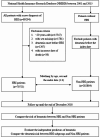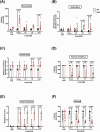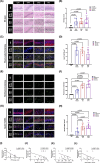Heat-related illness and dementia: a study integrating epidemiological and experimental evidence
- PMID: 38961437
- PMCID: PMC11221187
- DOI: 10.1186/s13195-024-01515-7
Heat-related illness and dementia: a study integrating epidemiological and experimental evidence
Abstract
Background: Heat-related illness (HRI) is commonly considered an acute condition, and its potential long-term consequences are not well understood. We conducted a population-based cohort study and an animal experiment to evaluate whether HRI is associated with dementia later in life.
Methods: The Taiwan National Health Insurance Research Database was used in the epidemiological study. We identified newly diagnosed HRI patients between 2001 and 2015, but excluded those with any pre-existing dementia, as the study cohort. Through matching by age, sex, and the index date with the study cohort, we selected individuals without HRI and without any pre-existing dementia as a comparison cohort at a 1:4 ratio. We followed each cohort member until the end of 2018 and compared the risk between the two cohorts using Cox proportional hazards regression models. In the animal experiment, we used a rat model to assess cognitive functions and the histopathological changes in the hippocampus after a heat stroke event.
Results: In the epidemiological study, the study cohort consisted of 70,721 HRI patients and the comparison cohort consisted of 282,884 individuals without HRI. After adjusting for potential confounders, the HRI patients had a higher risk of dementia (adjusted hazard ratio [AHR] = 1.24; 95% confidence interval [CI]: 1.19-1.29). Patients with heat stroke had a higher risk of dementia compared with individuals without HRI (AHR = 1.26; 95% CI: 1.18-1.34). In the animal experiment, we found cognitive dysfunction evidenced by animal behavioral tests and observed remarkable neuronal damage, degeneration, apoptosis, and amyloid plaque deposition in the hippocampus after a heat stroke event.
Conclusions: Our epidemiological study indicated that HRI elevated the risk of dementia. This finding was substantiated by the histopathological features observed in the hippocampus, along with the cognitive impairments detected, in the experimental heat stroke rat model.
Keywords: Amyloid plaque; Apoptosis; Cognitive deficits; Dementia; Epidemiology; Heat related illness; Hippocampus; Neurodegeneration.
© 2024. The Author(s).
Conflict of interest statement
The authors declare no competing interests.
Figures




Similar articles
-
Real-World Evidence for the Association between Heat-Related Illness and the Risk of Psychiatric Disorders in Taiwan.Int J Environ Res Public Health. 2022 Jul 1;19(13):8087. doi: 10.3390/ijerph19138087. Int J Environ Res Public Health. 2022. PMID: 35805746 Free PMC article.
-
Risk characterization of hospitalizations for mental illness and/or behavioral disorders with concurrent heat-related illness.PLoS One. 2017 Oct 16;12(10):e0186509. doi: 10.1371/journal.pone.0186509. eCollection 2017. PLoS One. 2017. PMID: 29036206 Free PMC article.
-
Increased Long-Term Risk of Dementia in Patients With Carbon Monoxide Poisoning: A Population-Based Study.Medicine (Baltimore). 2016 Jan;95(3):e2549. doi: 10.1097/MD.0000000000002549. Medicine (Baltimore). 2016. PMID: 26817904 Free PMC article.
-
Stroke rehabilitation is associated with a reduction in dementia risk: a population-based retrospective cohort study.J Rehabil Med. 2012 Apr;44(4):319-24. doi: 10.2340/16501977-0935. J Rehabil Med. 2012. PMID: 22366821
-
Mitigation strategies for heat-related illness during mass gatherings: Hajj experience.Front Public Health. 2022 Aug 18;10:957576. doi: 10.3389/fpubh.2022.957576. eCollection 2022. Front Public Health. 2022. PMID: 36062122 Free PMC article. Review.
Cited by
-
HSP70-Mediated Autophagy-Apoptosis-Inflammation Network and Neuroprotection Induced by Heat Acclimatization.Biology (Basel). 2025 Jun 27;14(7):774. doi: 10.3390/biology14070774. Biology (Basel). 2025. PMID: 40723334 Free PMC article. Review.
References
-
- Atha WF. Heat-related illness. Emerg Med Clin North Am. 2013;31(4):1097–108. 10.1016/j.emc.2013.07.012. - PubMed
-
- Miyake Y. Pathophysiology of heat illness: Thermoregulation, risk factors, and indicators of aggravation. Japan Med Assoc J. 2013;56:167–73.
-
- Gauer R, Meyers BK. Heat-related illnesses. Am Fam Physician. 2019;99(8):482–9. - PubMed
Publication types
MeSH terms
Grants and funding
LinkOut - more resources
Full Text Sources
Medical

